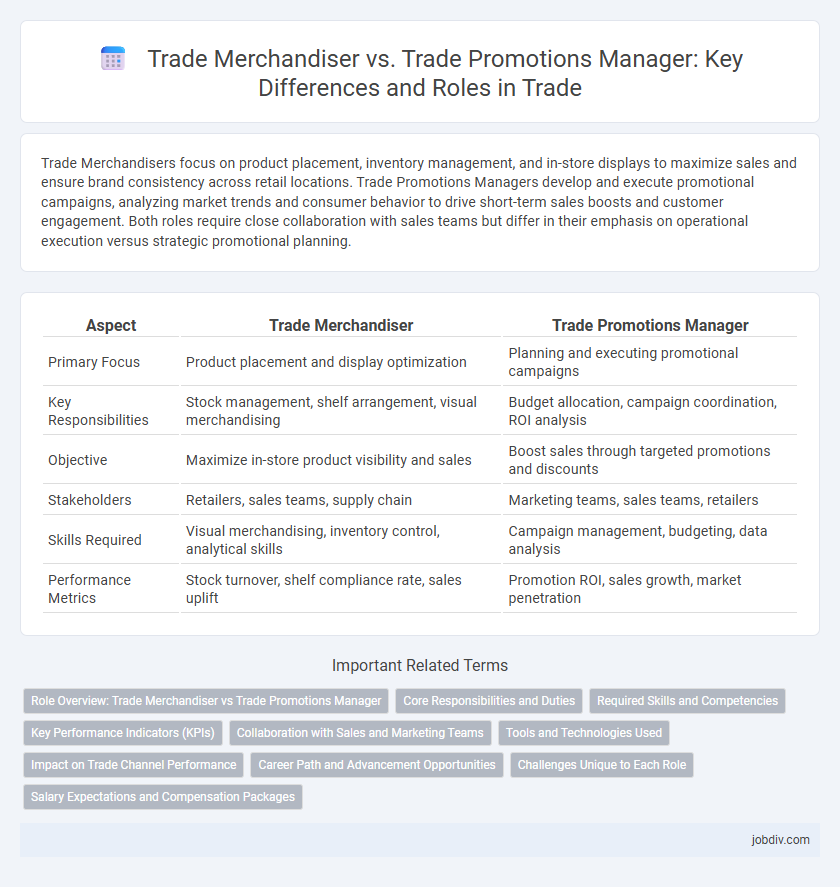Trade Merchandisers focus on product placement, inventory management, and in-store displays to maximize sales and ensure brand consistency across retail locations. Trade Promotions Managers develop and execute promotional campaigns, analyzing market trends and consumer behavior to drive short-term sales boosts and customer engagement. Both roles require close collaboration with sales teams but differ in their emphasis on operational execution versus strategic promotional planning.
Table of Comparison
| Aspect | Trade Merchandiser | Trade Promotions Manager |
|---|---|---|
| Primary Focus | Product placement and display optimization | Planning and executing promotional campaigns |
| Key Responsibilities | Stock management, shelf arrangement, visual merchandising | Budget allocation, campaign coordination, ROI analysis |
| Objective | Maximize in-store product visibility and sales | Boost sales through targeted promotions and discounts |
| Stakeholders | Retailers, sales teams, supply chain | Marketing teams, sales teams, retailers |
| Skills Required | Visual merchandising, inventory control, analytical skills | Campaign management, budgeting, data analysis |
| Performance Metrics | Stock turnover, shelf compliance rate, sales uplift | Promotion ROI, sales growth, market penetration |
Role Overview: Trade Merchandiser vs Trade Promotions Manager
A Trade Merchandiser primarily focuses on product placement, shelf management, and inventory tracking to maximize in-store visibility and sales. In contrast, a Trade Promotions Manager develops and executes promotional campaigns, collaborating with sales and marketing teams to drive product demand and enhance brand presence. Both roles are integral to retail success, with the merchandiser concentrating on execution and the promotions manager on strategic campaign planning.
Core Responsibilities and Duties
Trade Merchandisers focus on product placement, inventory management, and in-store display optimization to enhance product visibility and drive sales. Trade Promotions Managers develop, execute, and analyze promotional campaigns and trade marketing strategies to increase brand awareness and market share. Both roles collaborate with sales and marketing teams but differ in focusing on operational execution versus strategic promotional planning.
Required Skills and Competencies
Trade Merchandisers require strong analytical skills, attention to detail, and product knowledge to optimize in-store displays and inventory management, ensuring maximum product visibility. Trade Promotions Managers need expertise in strategic planning, budget management, and data analysis to design and execute promotional campaigns that drive sales growth and improve ROI. Both roles demand excellent communication and negotiation skills to collaborate effectively with retailers and suppliers.
Key Performance Indicators (KPIs)
Trade Merchandisers primarily track stock levels, shelf compliance, and product placement effectiveness to optimize in-store visibility and availability. Trade Promotions Managers focus on KPIs such as promotional ROI, uplift in sales volume during campaigns, and customer acquisition costs to evaluate the success of trade marketing activities. Both roles use sales growth and market share data but emphasize different aspects of the trade execution process for strategic decision-making.
Collaboration with Sales and Marketing Teams
Trade Merchandisers collaborate closely with sales teams to ensure product placement, inventory levels, and visual displays align with sales objectives and consumer demand trends. Trade Promotions Managers work alongside marketing teams to design and implement promotional campaigns that boost product visibility and drive sales growth through targeted offers and advertising strategies. Both roles require continuous communication and coordination with sales and marketing departments to optimize trade effectiveness and maximize revenue.
Tools and Technologies Used
Trade Merchandisers utilize inventory management software, planogram tools, and point-of-sale systems to optimize product placement and stock levels across retail locations. Trade Promotions Managers rely heavily on advanced analytics platforms, CRM software, and digital campaign management tools to design, execute, and measure promotional activities that boost sales and customer engagement. Both roles increasingly incorporate AI-driven insights and mobile applications to enhance decision-making and real-time communication with retail partners.
Impact on Trade Channel Performance
Trade Merchandisers directly influence shelf visibility and stock availability, driving immediate sales uplift through effective product placement and inventory management. Trade Promotions Managers design and execute promotional campaigns that boost customer demand and brand awareness, resulting in higher volume sales and market share growth. Both roles are critical for optimizing trade channel performance by balancing on-ground execution with strategic promotional planning.
Career Path and Advancement Opportunities
Trade Merchandisers typically begin their careers managing product displays and inventory at retail locations, gaining hands-on experience in visual merchandising and supply chain coordination. Trade Promotions Managers advance by developing and executing promotional campaigns, analyzing sales data, and collaborating with sales teams to drive revenue growth. Career progression often leads Trade Merchandisers into senior merchandising roles or transition into trade marketing, while Trade Promotions Managers may advance to roles such as Trade Marketing Director or Sales Strategy Manager, reflecting increased strategic responsibility and leadership.
Challenges Unique to Each Role
Trade merchandisers face challenges in inventory management and ensuring optimal product placement to maximize shelf visibility and consumer appeal in dynamic retail environments. Trade promotions managers encounter difficulties in designing effective promotional campaigns that balance budget constraints with ROI, while coordinating cross-functional teams and analyzing consumer response data for continuous improvement. Both roles demand strategic planning and close collaboration with sales and marketing to drive overall trade success.
Salary Expectations and Compensation Packages
Trade Merchandisers typically earn a salary ranging from $35,000 to $55,000 annually, with compensation packages often including performance bonuses and commission incentives based on sales volume. Trade Promotions Managers generally command higher salaries between $60,000 and $90,000, reflecting their strategic role in planning and executing promotional campaigns, complemented by bonuses, profit-sharing, and sometimes stock options. Both positions benefit from benefits like health insurance and retirement plans, but the Trade Promotions Manager's package is usually more comprehensive due to higher responsibility levels.
Trade Merchandiser vs Trade Promotions Manager Infographic

 jobdiv.com
jobdiv.com